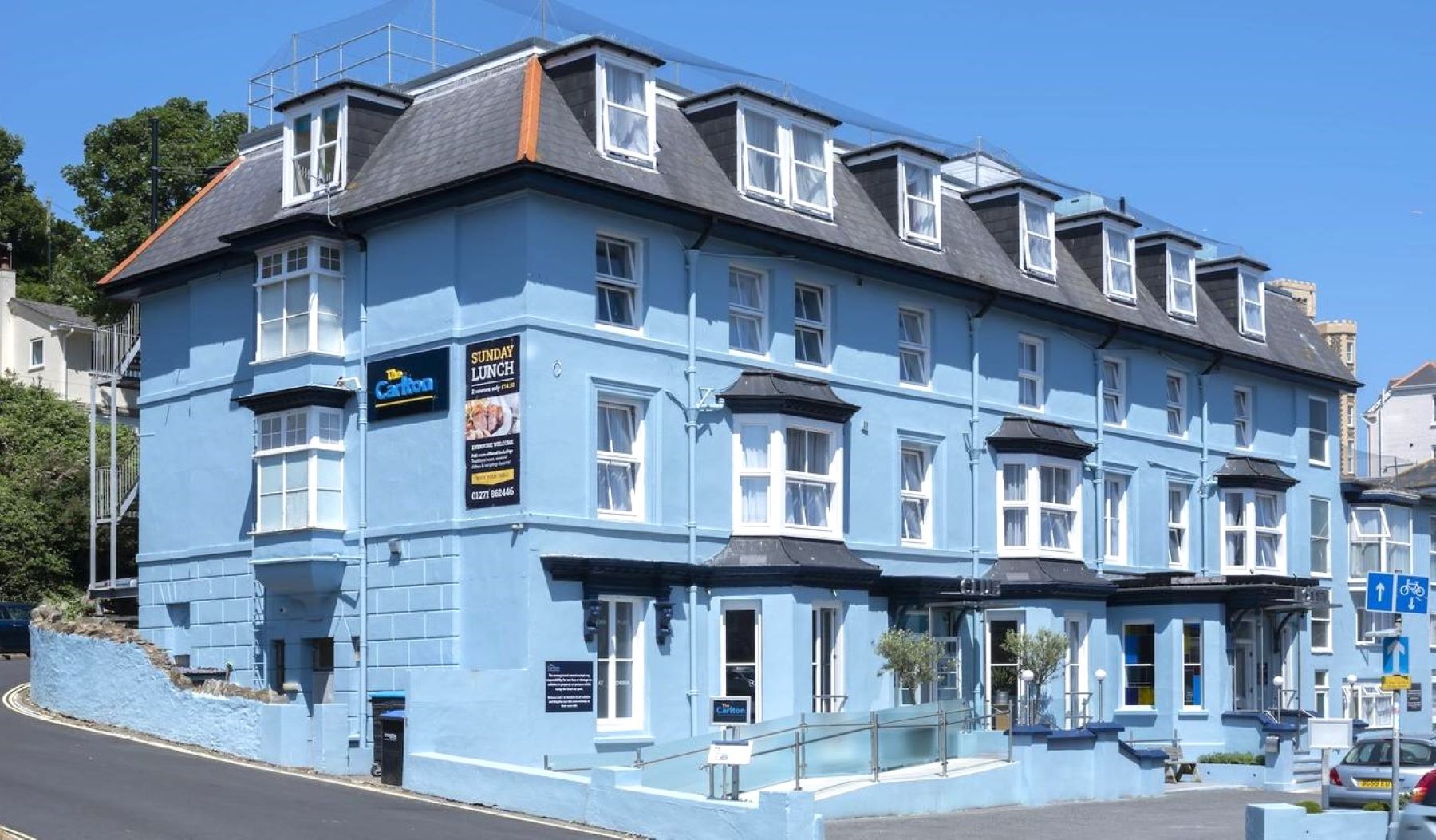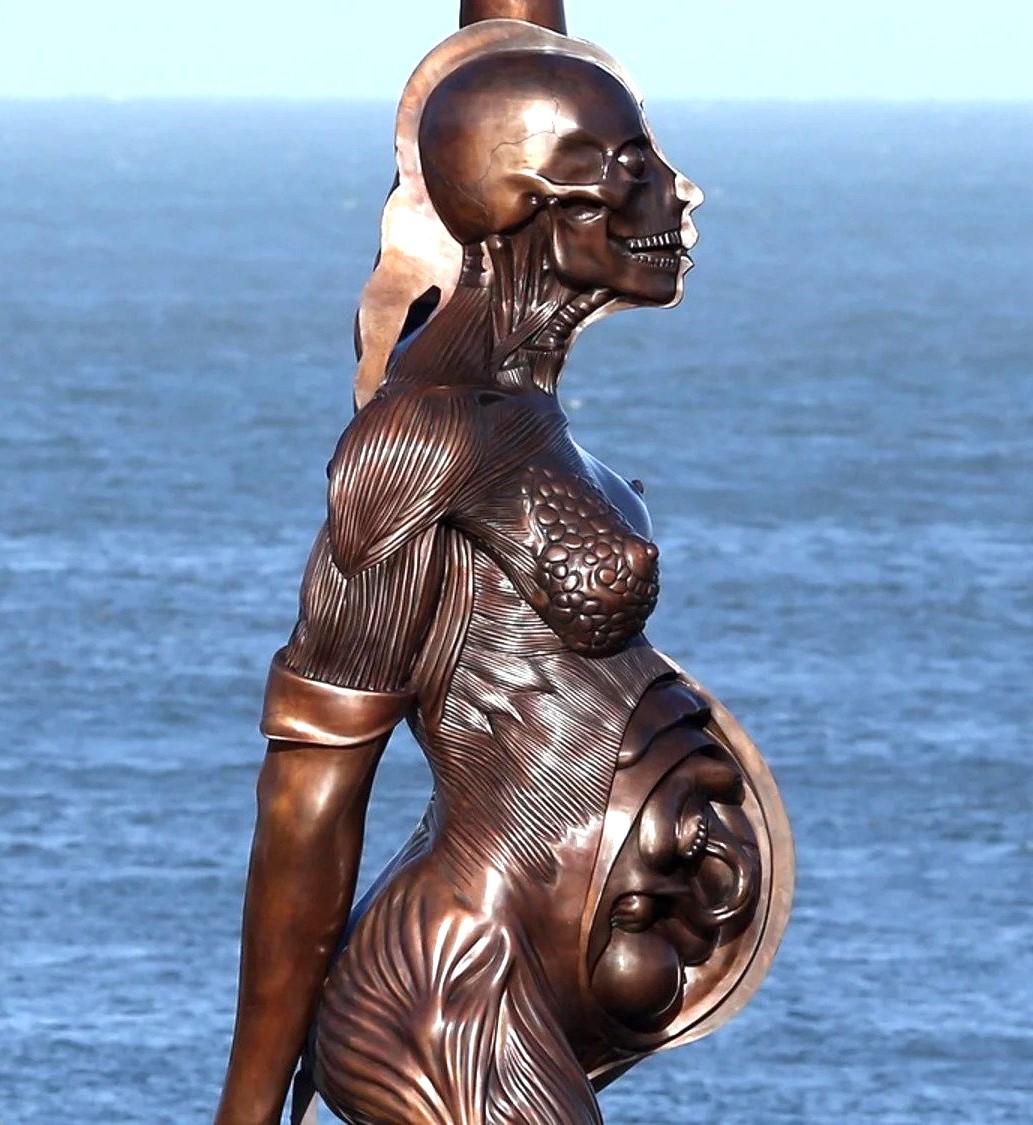
“Travel brings a special wisdom if one is open to it,” writes Phil Cousineau in The Art of Pilgrimage. I hope that statement is true, but it rarely feels that way when I am travelling. However, I do like to believe that when my wife Linda and I are on the road, there is an air of pilgrimage about us. We are usually on a quest for something, even if we are unsure about what that something is.
So, for this particular journey along a stretch of British coast we had never explored before, I had proposed to seek out a truly unusual and striking statue in the coastal town of Ilfracombe. When I first saw an image of the controversial sculpture on the internet, I believed it to be a digital joke of some sort. But then I learned that Verity (as it is called), was for real. I decided it was important for us to see it and its unlikely host town of Ilfracombe, for ourselves.
The weather was moderately good for the off-season, and we congratulated ourselves for cleverly avoiding the tourists. As Canadian travelers, already soaked from several days of hiking in the rain, we were sure that we could easily handle anything the mild southwest coast of the U.K. could throw at us.
Arriving at Ilfracombe from the south on the A361, the first impressions were not so promising. I wondered out loud to Linda whether or not it was a good idea to watch those YouTube travel videos before visiting any destination. You know the ones I mean; the videos with generic New Age music soundtracks and walking hand-held camera shots of the town showing all the predictable landmarks.
Nonetheless, the drone footage of this town with the ragged hills and cliffs surrounding it was enticing. And yet, if I lost my patience here, the whole Victorian seaside resort promotions might send me running for those hills, I mused.
Such long-winded rants on my part eventually wind down as my travelling companion advises me to forget about the hype and just see and enjoy what the place has to offer.
So, I silenced my voice and opened my eyes to what we might find.
Soon enough, we saw the welcoming sign and were driving, more or less, towards the harbour on High Street. I had read that along here was the notorious Bongs and Biscuits shop that sold cannabis smoking equipment along with “retro snacks”, as well as fish and chips. It was raided by the cops in 2019 after local complaints to the town council. This part of town was labelled by the media as “seriously deprived,” but it was not stated clearly what it was deprived of. Still, this bit of background revealed to this traveler that Ilfracombe would be a mixed bag of the old and the new, and if we looked in the right place, there would most certainly be surprises in this civil parish of 11,000 souls.
 Like so many town names, the origins were not exactly clear, but I was willing to buy into the Norse/Anglo-Saxon/Celtic theory that suggested it meant “the valley with the bad ford” (not the car, of course, but a place to cross over a watercourse.) And, like everywhere else in the Celtic world we had ever travelled, there was a long and convoluted history to this small enclave etched into the coast of England.
Like so many town names, the origins were not exactly clear, but I was willing to buy into the Norse/Anglo-Saxon/Celtic theory that suggested it meant “the valley with the bad ford” (not the car, of course, but a place to cross over a watercourse.) And, like everywhere else in the Celtic world we had ever travelled, there was a long and convoluted history to this small enclave etched into the coast of England.
It seems to have been a conveniently located port to set off for various invasions beginning with an incursion into Ireland deemed appropriate by King John in 1208. In 1247, another convoy of ships charged off to capture the Outer Hebrides of Scotland. Later it provided a staging place for a siege of Calais, France, and yet another military attack on Ireland.
My gut instinct is to get to the sea as quickly as possible when entering any coastal town and, if it is overly developed and thick with tourists, head further along the coast. Fortunately for us, it seemed that all the big apartment blocks were high above town in the hills, where I am sure they had magnificent views. And, as it was raining again, most tourists were either in the pubs or had already fled.
I wasn’t sure at first that we could find what we were looking for – a twenty-meter-tall statue called Verity that was about the oddest piece of sculpture in any town I had ever visited. But it was said to be right on the harbour as well, so our pilgrimage was coming together nicely.
On the way, we were able to take in some of the more notable features of Ilfracombe. I was duly impressed by a place aptly named “The Tunnels.” According to their official website, “In 1823 a team of hundreds of Welsh miners hand carved through the cliffs to allow easy access to Crewkhorne Cove and, subsequently, three tidal bathing pools – two allocated for the ladies and one for the gentlemen. The beaches were then renamed ‘Tunnels Beaches.’”
Today, as in Victorian times, you can walk through these nifty man-made caves to get to some very attractive tidal pools for swimming, lounging about on the sand, or poking around the rocks for crabs and whelks. It was here I caught up on the lore of Victorian sea bathing in all its odd glory and was introduced to the story of an 1800s inventor – named simply Dr. Nichols – who was involved in the promotion of “decency, comfort, and especially the safety of the invigorating exercises of bathing and swimming.” To that end, he had invented the “buoyant bathing dress,” the “pocket swimming life preserver” (only 3 ounces), and the “Aquatic Velocipede.”
Ilfracombe clearly became a veritable magnet for hydrotherapists, sea lovers, bathing enthusiasts, and most anyone hoping to cash in on the fashionable Victorian fascination with all things sea-related. And that included the famous Prof. H. Parker (“winner of 159 prizes”) who came to town more than once in the 1890s “to impart instructions in swimming to ladies and gentlemen.” Somehow, he had cobbled together a career of fame involving both swimming instruction and escape artistry. Perhaps Victorian times around Ilfracombe were much more interesting than I ever imagined.
Of course, back in the day, there was an elaborate etiquette guide provided at the Tunnels for all ages that included everything anyone needed to know about being proper in public. For boys, the author of this guide instructed to, “lower your voice sometimes; not everyone is deaf” and for girls, “when you talk, keep your hands still.”

Well, if I wasn’t convinced yet that Ilfracombe was an odd but interesting place, I became curious as to the nature of two tall, somewhat conical, white protruding structures plunked down between the road we were on and the water. When I stopped and got out of the car, I asked a rather bored-looking gent in a flat cap sitting on a bench what I was looking at. “That there is known as Madonna’s Bra,” he said and then studied the strange look on my face. “It’s actually the Landmark Theatre,” he added, “but you can see how the other name stuck.” Indeed.
It turns out that the towers were built with 300,000 white Belgian bricks and were constructed as an entertainment venue that is quite popular with those touring British cover bands.
Nearby was the Ilfracombe Museum, which was not on my wish list but might have served as a backup if the Devonian rain proved relentless. Fortunately, the sea wind dropped slightly, and the pelting rain let up. But if it had not, I would have taken Linda in to study the many collections inside that included the following: domestic social items (!), agricultural items – mainly hand tools, clocks, watches, coins, tokens, medals, “edged weapons,” butterflies, and their famous “collection of British Bats preserved in fluid.” Alas, it was decided to save that for an even rainier day.
Parking was a bit iffy near our destination, but we ended up on the very wharf at the foot of Lantern Hill, with its fourteenth-century St. Nicholas’s Chapel, “the oldest working lighthouse in the U.K.” at the top.
We first took a vigorous hike to the top of the hill to get a good look at the overall town and take our first bird’s eye view of the curious and controversial monument below that we had come to see.
We hastily climbed up the slippery path to snap a few photos and then retreated down to get up close and personal with a woman named Verity.
Art critic Jonathan McAloon states, “A controversial eyesore, Damien Hirst’s sculpture in Ilfracombe, Devon, embodies the false promise of gentrification, the capricious back and forth of public opinion, and an ugly post-Brexit future.”
I can’t say that I agree with his overly critical view of the work, but I would more likely defend this downright weird creation as something intriguing to anyone who is generally bored by public works of art. The Carlton Hotel, high on the hill above Verity, describes her in more generous terms: “Verity is 25 tons of pregnant woman. Her skin is partially flayed with internal anatomy displayed, foetus clearly visible. She is holding a sword aloft, hiding the scales of justice behind her back while standing on a pile of books.” Say what?
Yes, that’s just what she is. The statue is positioned strategically at the mouth of the harbour, staring out towards Wales far, far away. Once the tallest statue in the U.K., it was erected here in 2012 and is on a twenty-year loan from her creator, Daniel Hirst who reminds us that her name means “truth” and that she is a “modern allegory of truth and justice.” Like her critics, I can’t quite piece together how that allegory works or what it means. But this is one crazy work of art. And I am glad that I came to pay my respects.

According to the Sunday Times, Hirst, who lives in the area, is one of the world’s richest artists, sitting on a stash of $384 million (US), so he may not care if everyone loves his rendition of truth (and justice) in bronze and stainless steel. He appears to be a controversial figure and has been challenged in court a number of times over his work, including plagiarism involving a creation based on a child’s toy. He also reports a funny story about his youth involving a mother who cut up his “bondage trousers” and melted one of his Sex Pistol albums on the stove to turn it into a fruit bowl. Somehow, to this novice art critic, knowing these several curious details about the creator of Verity makes the art all that more intriguing.
When many locals voiced their outrage over the creation, the town council stood by its decision to install the controversial metal pregnant woman and were more than pleased when her presence increased tourist traffic dramatically for a seaside resort that had seen better days. And I guess it was Verity who had lured us here after all, in my modest never-ending search for truth in whatever form it may take. So, hats off to the visionary councillors, to the wealthy Mr. Hirst, and to Verity herself. ~ Story by Lesley Choyce




















Leave a Comment